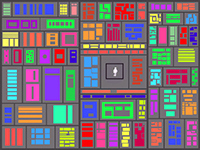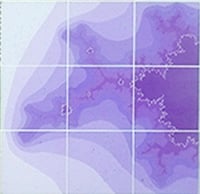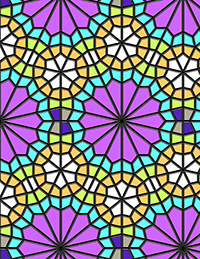Welcome to our annual end of year special - a celebration of work submitted by readers of this column, BCS & Computer Arts Society members.
(All submissions received have been used and are presented here in alphabetical order. All images are copyright the artist, reproduced with permission.)
Anna Cambell Bliss, first became involved with computing when she arrived in Utah in 1964: ‘I like programming for the direct relationship with the computer rather than going through a canned program that is not my thought, or thinking.’Fractalscape is a mural dating from the late 1980s programmed in C and transferred photographically to silk screens for more permanent printing - it was very labour intensive, requiring over 72 printings.
She tells me ‘The image is a portion of the Mandlebrot set, named for the famous mathematician, who saw the mural exhibited in Washington at the American Association for the Advancement of Science. He later came to call on me while visiting colleagues in Salt Lake City. I had some concerns about his reaction because I had taken many liberties in giving form to the mathematics!’
Coming from a distinguished fine arts background she studied art history, architecture and, at MIT in the 1950s, colour with Gyorgy Kepes (of Chicago Bauhaus fame). Thus it is not surprising that Anna is interested in exploring connections between poetry and mathematics, nature and the constructed environment. She writes, ‘Often the most exciting ideas emerge at the intersection where more than one discipline meets.’ The documentary film of her life came out last year ARC OF LIGHT: A Portrait of Anna Campbell Bliss.
Brian Winchmann is the author of tiling database TilingSearch, a comprehensive collection of high quality images of geometric tiling patterns. A search facility allows the user to locate images by means of their geometric properties or their source.
Although the site contains much historic material, it does contain original art work by Tony Lee whose patterns are in the Islamic style. Tony writes ‘My aims, if any, when I invent these patterns is not to produce computer graphics, but simply to explore possibilities which seem not to have been noticed by the original Muslim pattern makers.
I have always been interested in investigating new star patterns, using the techniques and motifs of authentic Islamic geometric patterns, but applying different means of combinatorial analysis to seek out new combinations of star motifs in the plane, either using stars with various numbers of points which have already been used in authentic patterns, but in different, non-authentic arrangements; or using stars where the numbers of points don’t seem to occur in any authentic Islamic ornament.’ TilingSearch really is a tour de force and well worth checking out, especially if you have an interest in maths and patterns.
 Click image to enlarge
Click image to enlargeCredit: Susan Rosenberg, Hide'n Seek at the Atelier, pastel, graphite, archival ink on paper, 112 x 82.5cms, 2013
Although still rooted in the pleasure she derives from paint Susan Rosenberg utilises new technology to explore different ways of thinking, creating multi-layered art works. She came to computing in 1999 having had a ‘moment of revelation’, and decided to seek out body scanning equipment at UCL (originally developed by the US Military to measure recruits for uniforms). Using a human-sized cubicle to scan models, the images were later manipulated with 3D software in the studio.
Coming from a traditional fine arts background in life drawing and print-making, Susan found this layered process suited her way of working. She tells me, ‘I had found the ghost in the machine, or rather the machine had helped me visualise the ghosts in my head. It was such a liberation.’
She moved on to scanning still-life objects. 3D software has improved greatly since her early days, but as one of her themes is memory, the artist continues to work with the original scans, interpreted in a new way - addition and subtraction, introduction of new colour and line is accomplished with greater ease. A slice of the 3D image is selected and printed, making a transition from 3D to 2D. The image is rescanned at high resolution, colour and tone is adjusted and the image printed with archival ink onto canvas or cotton rag paper with a scale greatly enlarged from the original.
 Click image to enlarge
Click image to enlargeCredit: Sally Sheinman, What Makes You, You? number 91: I’m afraid what makes me me is a perpetual profound loneliness consoled by the delusion of work and a pathetic accumulation of hours spent organising stuff for other people in the hope of appreciation! Inspired by Carry Akroyd, 2013
Sally Sheinman’s interactive digital art project What Makes You, You? aimed to produce a new kind of portraiture. Running from February to September 2013, the project invited people to answer the highly personal, yet universal question: ‘What makes you, you?’ Participants submitted answers via a bespoke website, Twitter (#WhatMakesYouYou) or Facebook.
Every day for six months, the artist chose one answer as an inspiration for a series of drawings she produced on the iPad (using the Brushes app), which she sees as a new medium, ‘providing opportunities for a new pallet, new mark making and a more spontaneous and flexible means of capturing an idea.’ The huge variety of answers that Sally received translated into a striking variety of art works (one example is shown here). Although each is different, Sally’s own style shines through each work culminating in a truly cooperative body of portraiture.
Sally tells me, ‘I am fascinated by people, their similarities and differences genetically, culturally, socially, and individually. I have always been interested in drawing people into a dialogue with me and my painting practice, through simple yet big questions.’ Sally’s unique project would not have been possible without digital technology - it is about the medium but it also speaks to the shared experience of being human and what it means to live in our networked, highly technological age.
Catherine Mason is the author of A Computer in the Art Room: the origins of British computer arts 1950-80, published in 2008.
More information on the Computer Arts Society, including our events programme
Visit the Computer Arts Society on Facebook














